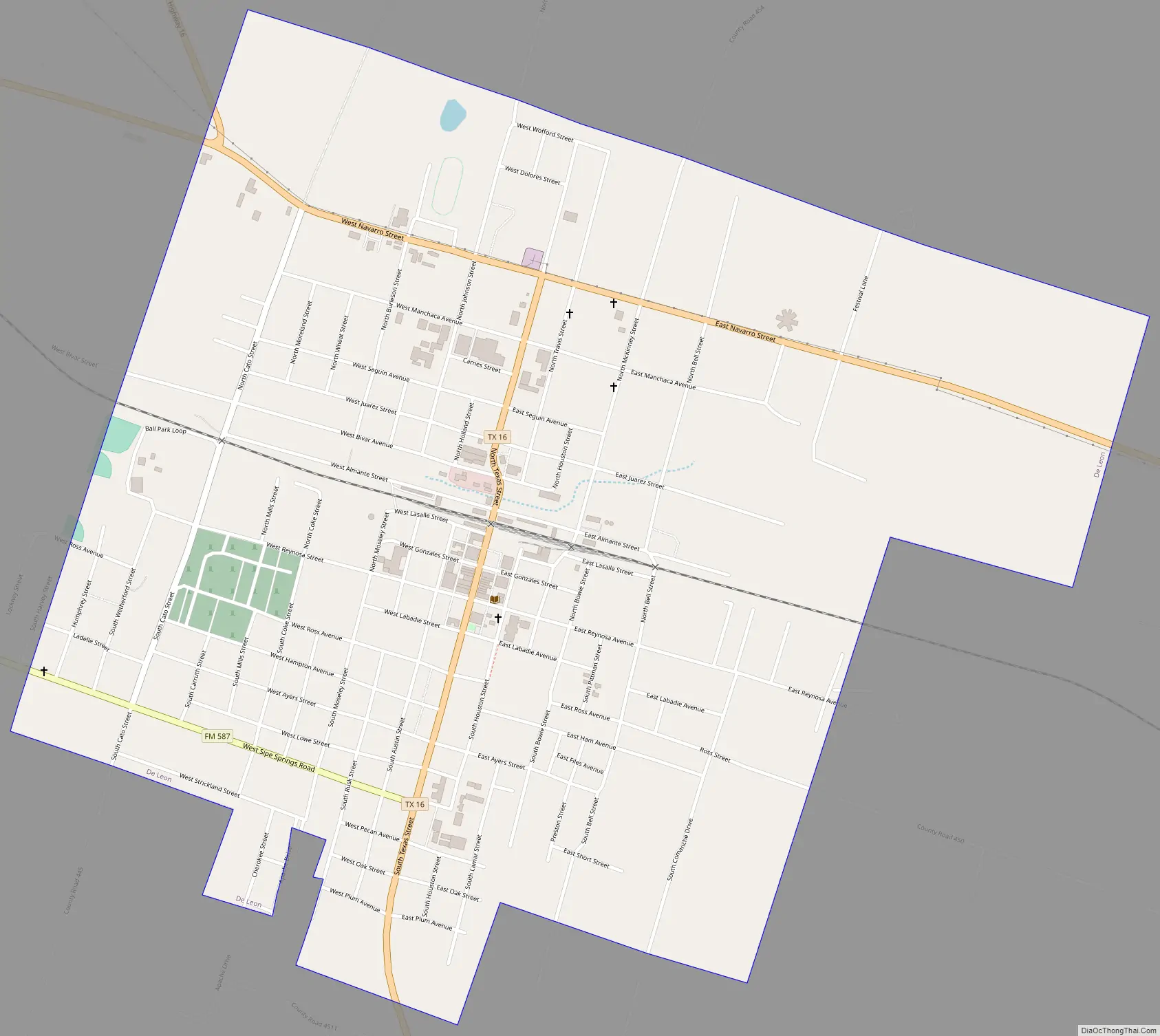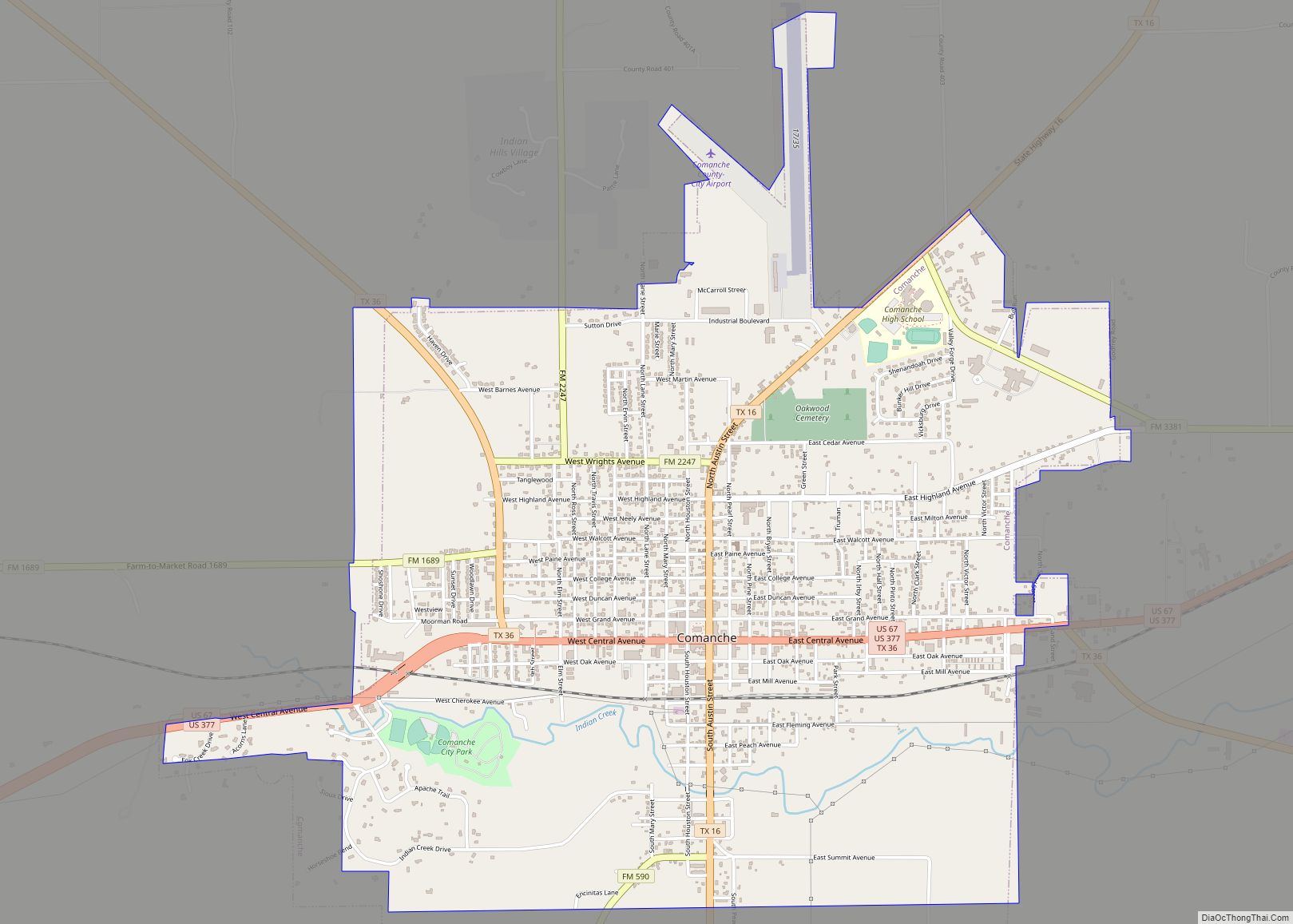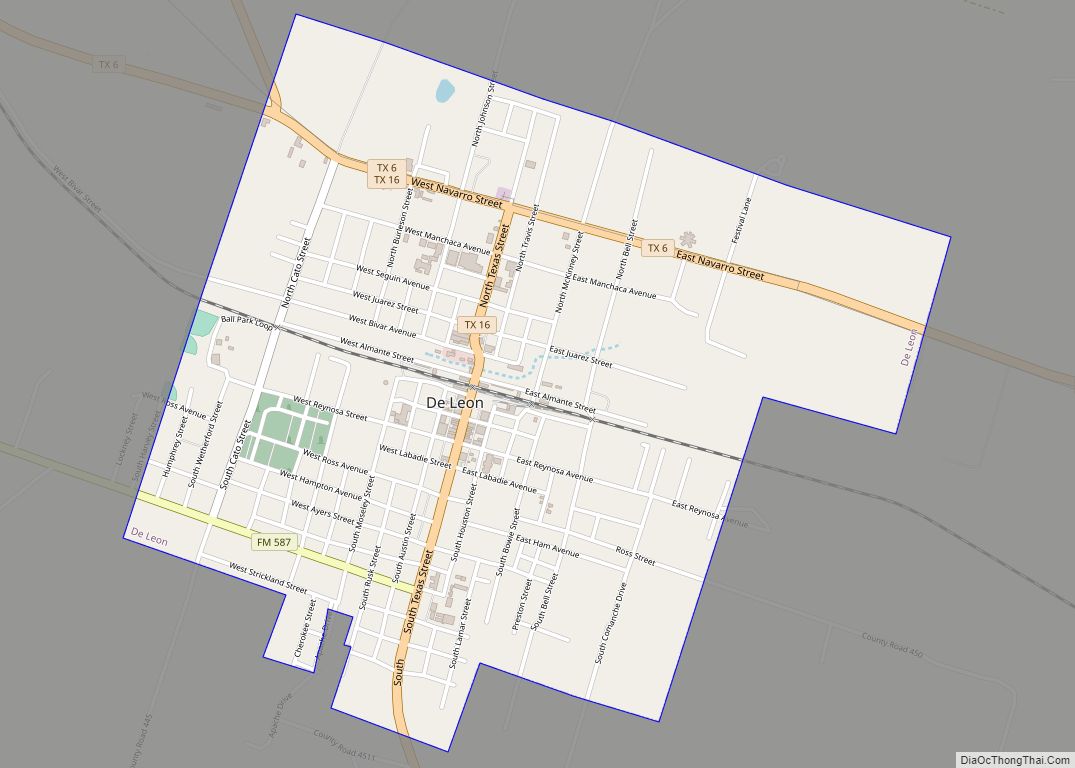De Leon (/dɪ ˈliːɒn/ dih LEE-on) is a city located in Comanche County in the U.S. state of Texas. Its population was 2,246 in the 2022 census. It is commonly associated with being named after the Spanish explorer Ponce de León, but the town is actually named for its location on the Leon River (de León in Spanish), which flows directly north and east of the community, and drains into nearby Proctor Lake.
| Name: | De Leon city |
|---|---|
| LSAD Code: | 25 |
| LSAD Description: | city (suffix) |
| State: | Texas |
| County: | Comanche County |
| Elevation: | 1,280 ft (390 m) |
| Total Area: | 2.24 sq mi (5.81 km²) |
| Land Area: | 2.24 sq mi (5.81 km²) |
| Water Area: | 0.00 sq mi (0.00 km²) |
| Total Population: | 2,246 |
| Population Density: | 980.37/sq mi (378.57/km²) |
| ZIP code: | 76444 |
| Area code: | 254 |
| FIPS code: | 4819672 |
| GNISfeature ID: | 1334129 |
| Website: | www.cityofdeleon.org |
Online Interactive Map
Click on ![]() to view map in "full screen" mode.
to view map in "full screen" mode.
De Leon location map. Where is De Leon city?
History
The town was laid out in April 1881 by surveying crews of the Texas Central Railway as part of the historic Missouri-Kansas-Texas Railroad (KATY) as it constructed a line from Ross just north of the Waco area, to Stamford, with the ultimate goal of extending the line to Colorado. The first city lots were auctioned on July 7, 1881, by Robert Morris Elgin, the Texas Central’s land agent and for whom the town of Elgin had been named.
Initially incorporated by an election held on August 30, 1890, the town government appears to have dwindled over the years, and the community was reincorporated in an election held August 29, 1899. The first mayor elected under the new incorporation was former Comanche County Judge John Lambert, who took office in April 1900.
Expulsion of the Black population
After a murder that led to the lynching of a Black suspect, the white residents of Comanche County visited all black residents and told them to leave the county within 10 days. In fact, the lack of Black population was later a source of civic pride. At the railroad station, a sign read “Nigger, don’t let the sun go down on you in this town.” Black porters would hide in the baggage cars in Comanche County.
Arrival of the train line
The population of De Leon remained under 1,000 until 1910, when a branch of the Texas Central line, then leased by the Katy Railroad, was constructed from De Leon to Rising Star and Cross Plains. It was the only town in Comanche County with railroad service and a station. De Leon then became the center point for the Katy between Waco, Albany, and Cross Plains, thereby relocating numerous railroad crew members and their families to the city. The census of 1910 showed 1,015 citizens. De Leon continues to retain its rail service and the former Texas Central Katy line from Dublin to Gorman, nicknamed the “Peanut Line”, is currently operated by the Fort Worth and Western Railroad.
On Labor Day night 1918, oil was discovered north of De Leon just inside the Comanche County line near Desdemona. During the next two years, nearly 1000 wells were drilled in the area, and the population of De Leon rose to an estimate of more than 5,000 people. The boom was short-lived, though, and by the time the actual was census taken in 1920, the population was only 3,302. Since World War II, De Leon’s population has stabilized around 2,500.
Ranching dominated Comanche County until the coming of the Texas Central in 1881. Cotton soon became the primary crop, as immigrants from the Southern states, and in particular the area around Oxford and Pontotoc, Mississippi, came to the De Leon vicinity starting in 1890. When the boll weevil began to make inroads in the area after 1910, farmers just west of town began to plant the small Spanish peanut. That quickly became the dominant crop, and in 1913, the De Leon Peanut Company was organized. Over time, Comanche County became the leading peanut-producing county in the U.S. Coupled with production around the neighboring community of Gorman in Eastland County, most of the peanuts went into candy, particularly Curtis Candies’ Baby Ruth and Butterfinger candy bars. Nabisco eventually purchased the De Leon Peanut Company. In the 21st century, peanut production has dropped dramatically.
De Leon has one of the oldest festivals in Texas, the De Leon Peach and Melon Festival, which had its beginnings in 1914. Celebrated during the first full week in August, it draws thousands to its numerous events, including a carnival, tractor pulls, car show, and a free cold watermelon slicing. The current watermelon seed-spitting distance record, as recognized by the Guinness Book of World Records, of 75 feet 2 inches, was set at the festival on August 12, 1995, by Jason Schayot, then of Georgetown, Texas. Schaynot is a descendant of two long-time De Leon families.
Among De Leon’s unique events is the only paid appearance by Elvis Presley in which he sang only gospel music. It occurred at Hodges Park on July 4, 1955, when he followed his friends, the Blackwood Brothers, at the Battle of Songs show. The Blackwoods had lost family members in a plane crash in Alabama the previous year, just prior to a scheduled appearance in De Leon, and had remembered them in a performance immediately preceding Elvis’ performance. Elvis followed with more gospel music. It was one of three appearances Elvis made that day for promoter W.B. Nowlin, then mayor of De Leon. The other two were in Brownwood and Stephenville.
Included among De Leon’s most distinguished citizens are former Texas Speaker of the House and later Lieutenant Governor Ben Barnes, a protégé of John B. Connally and Lyndon B. Johnson, and the 1955 Pulitzer Prize winner William White, whose The Taft Story focuses upon Republican presidential contender Robert A. Taft. Winston Lee Moore, composer and singer of “Don’t Let the Stars Get in Your Eyes”, was reared just north of De Leon. He is better known under his stage name, Slim Willet. Former State Representative Sid Miller was born in De Leon in 1955; he was a candidate for Texas Agriculture Commissioner in the Republican primary election scheduled for March 4, 2014.
Buried in the De Leon Cemetery is Cyrus Campbell, an early resident, who was the blacksmith who made the leg irons placed on Mexican General Antonio López de Santa Anna following his capture at the Battle of San Jacinto. According to Campbell’s family tradition, his three brothers and he were the men who actually captured Lopez de Santa Anna the day following the battle.
The town motto, “Busiest Town, Friendliest People”, is a reminder of the slower-paced lifestyle still available in a few communities in this country.
De Leon Road Map
De Leon city Satellite Map
Geography
De Leon is located at 32°6′35″N 98°32′19″W / 32.10972°N 98.53861°W / 32.10972; -98.53861 (32.109746, –98.538488).
According to the United States Census Bureau, the city has a total area of 2.1 square miles (5.4 km), all of it land.
Climate
The climate in this area is characterized by relatively high temperatures and evenly distributed precipitation throughout the year. The Köppen climate classification describes the weather as humid subtropical, Cfa.
See also
Map of Texas State and its subdivision:- Anderson
- Andrews
- Angelina
- Aransas
- Archer
- Armstrong
- Atascosa
- Austin
- Bailey
- Bandera
- Bastrop
- Baylor
- Bee
- Bell
- Bexar
- Blanco
- Borden
- Bosque
- Bowie
- Brazoria
- Brazos
- Brewster
- Briscoe
- Brooks
- Brown
- Burleson
- Burnet
- Caldwell
- Calhoun
- Callahan
- Cameron
- Camp
- Carson
- Cass
- Castro
- Chambers
- Cherokee
- Childress
- Clay
- Cochran
- Coke
- Coleman
- Collin
- Collingsworth
- Colorado
- Comal
- Comanche
- Concho
- Cooke
- Coryell
- Cottle
- Crane
- Crockett
- Crosby
- Culberson
- Dallam
- Dallas
- Dawson
- Deaf Smith
- Delta
- Denton
- Dewitt
- Dickens
- Dimmit
- Donley
- Duval
- Eastland
- Ector
- Edwards
- El Paso
- Ellis
- Erath
- Falls
- Fannin
- Fayette
- Fisher
- Floyd
- Foard
- Fort Bend
- Franklin
- Freestone
- Frio
- Gaines
- Galveston
- Garza
- Gillespie
- Glasscock
- Goliad
- Gonzales
- Gray
- Grayson
- Gregg
- Grimes
- Guadalupe
- Hale
- Hall
- Hamilton
- Hansford
- Hardeman
- Hardin
- Harris
- Harrison
- Hartley
- Haskell
- Hays
- Hemphill
- Henderson
- Hidalgo
- Hill
- Hockley
- Hood
- Hopkins
- Houston
- Howard
- Hudspeth
- Hunt
- Hutchinson
- Irion
- Jack
- Jackson
- Jasper
- Jeff Davis
- Jefferson
- Jim Hogg
- Jim Wells
- Johnson
- Jones
- Karnes
- Kaufman
- Kendall
- Kenedy
- Kent
- Kerr
- Kimble
- King
- Kinney
- Kleberg
- Knox
- La Salle
- Lamar
- Lamb
- Lampasas
- Lavaca
- Lee
- Leon
- Liberty
- Limestone
- Lipscomb
- Live Oak
- Llano
- Loving
- Lubbock
- Lynn
- Madison
- Marion
- Martin
- Mason
- Matagorda
- Maverick
- McCulloch
- McLennan
- McMullen
- Medina
- Menard
- Midland
- Milam
- Mills
- Mitchell
- Montague
- Montgomery
- Moore
- Morris
- Motley
- Nacogdoches
- Navarro
- Newton
- Nolan
- Nueces
- Ochiltree
- Oldham
- Orange
- Palo Pinto
- Panola
- Parker
- Parmer
- Pecos
- Polk
- Potter
- Presidio
- Rains
- Randall
- Reagan
- Real
- Red River
- Reeves
- Refugio
- Roberts
- Robertson
- Rockwall
- Runnels
- Rusk
- Sabine
- San Augustine
- San Jacinto
- San Patricio
- San Saba
- Schleicher
- Scurry
- Shackelford
- Shelby
- Sherman
- Smith
- Somervell
- Starr
- Stephens
- Sterling
- Stonewall
- Sutton
- Swisher
- Tarrant
- Taylor
- Terrell
- Terry
- Throckmorton
- Titus
- Tom Green
- Travis
- Trinity
- Tyler
- Upshur
- Upton
- Uvalde
- Val Verde
- Van Zandt
- Victoria
- Walker
- Waller
- Ward
- Washington
- Webb
- Wharton
- Wheeler
- Wichita
- Wilbarger
- Willacy
- Williamson
- Wilson
- Winkler
- Wise
- Wood
- Yoakum
- Young
- Zapata
- Zavala
- Alabama
- Alaska
- Arizona
- Arkansas
- California
- Colorado
- Connecticut
- Delaware
- District of Columbia
- Florida
- Georgia
- Hawaii
- Idaho
- Illinois
- Indiana
- Iowa
- Kansas
- Kentucky
- Louisiana
- Maine
- Maryland
- Massachusetts
- Michigan
- Minnesota
- Mississippi
- Missouri
- Montana
- Nebraska
- Nevada
- New Hampshire
- New Jersey
- New Mexico
- New York
- North Carolina
- North Dakota
- Ohio
- Oklahoma
- Oregon
- Pennsylvania
- Rhode Island
- South Carolina
- South Dakota
- Tennessee
- Texas
- Utah
- Vermont
- Virginia
- Washington
- West Virginia
- Wisconsin
- Wyoming







